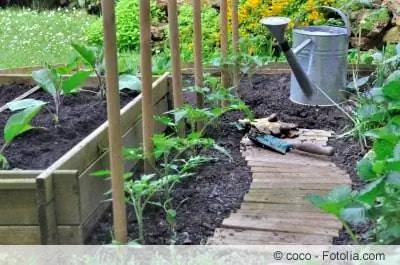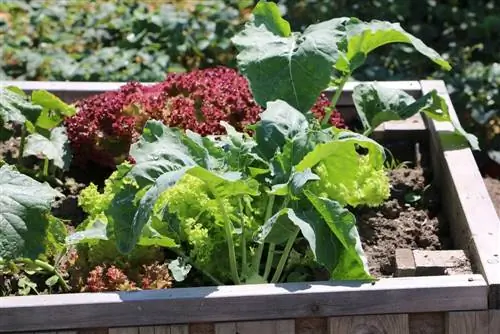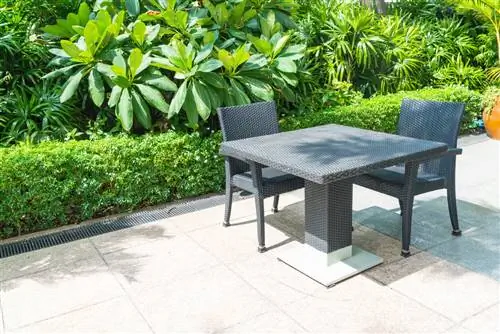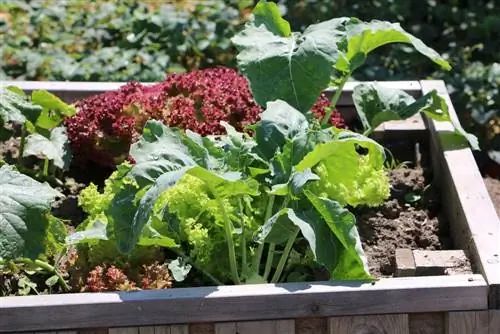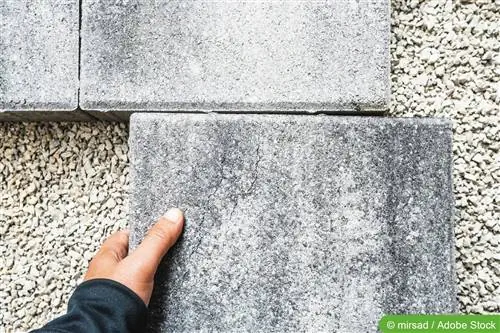- Author admin [email protected].
- Public 2023-12-17 03:39.
- Last modified 2025-06-01 06:48.
If you decide to place bed slabs in your garden, you shouldn't just go by the look. The frost hardness and weather resistance of the material must also be taken into account. Purely practical considerations, such as the size of the bed, transport to the home garden and the cost of the material, also play a role in the selection. It's best to get a brief overview of the different materials available commercially.
Material
What materials are there? What advantages and disadvantages can be expected? Below is a little insight into the world of bed slabs. First you have to decide on the right material:
- Wood
- Stone
- Plastic
Wood panels
Wood panels always appear warm and natural in nature. Depending on the type of wood, they are also quite weather-resistant. Their big disadvantage is the slippery surface when it rains. Entering can then become a dangerous game of sliding.
- Tree discs - the tree disc panels are probably the front runners for this, they are quite inexpensive and visually fit very harmoniously into their surroundings.
- Wooden tiles - Surface-treated wooden tiles, for example made from acacia wood, ensure greater traction in any weather. Depending on the type of wood and the amount required, it can be quite expensive. Ten wooden tiles (acacia wood) cost around 30 euros.
- Wooden taxiway - Roll-out running boards, for example made of larch wood, are also quite practical. Grooves in the boards and spaces between the boards ensure more traction. Two and a half meters cost between 15 and 20 euros.
Stone slabs
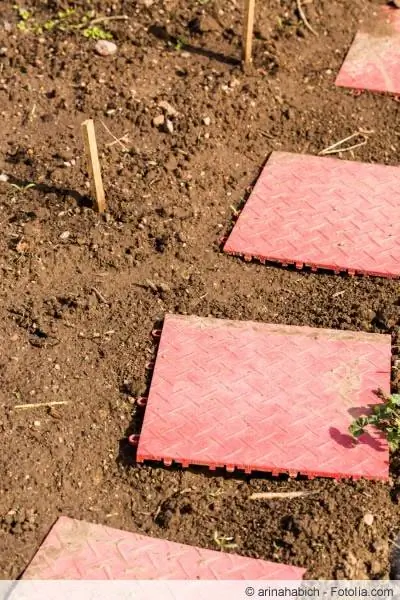
Stone slabs offer a wide range of looks and in most cases appear very natural. Depending on the choice of material, shape and workmanship, they can appear elegant or more rustic. In any case, they are very robust and durable. Safe footing in rainy weather depends heavily on the material and surface structure of the stones.
- Paving stones, stone tiles - With paving stones and stone tiles, the size of the treads can be freely designed. But this requires more laying work and skill so that they don't drift apart at the first downpour or frost.
- Stone slabs - Complete stone floor slabs are easier to lay, but are usually quite heavy. Prices for stone floor tiles vary depending on the type of stone. However, they are usually higher than with wood or plastic. The cheapest option is concrete stepping stones. However, these usually don't look that appealing. Granite slabs with a rough surface are commercially available as “step stones”. Round, with a diameter of approx. 45 cm, they are affordable for around 15 euros each, depending on how many you need. They are functional and harmonize perfectly with nature.
- Decorative stepping stones - Cast concrete stepping stones decorated with stones, impressions or engravings are particularly pretty. Here we also come across the tree discs again, which, depending on how they are processed, can hardly be distinguished from a real tree disc. A sturdy alternative to real construction discs.
If it's more about the look or you only need to take one or two steps into the bed, there is now a large selection of decorative stepping stones. Such stones are relatively easy to make yourself. Of course, it takes a lot of time. But this brings artistic and personal accents into the bed. Sure-footed, of course.
Tip:
There are many instructions on the Internet for creative, homemade stepping stones. You can make imaginative bed slabs yourself with just a spade, some mortar and a trowel.
Plastic sheets or mats
Plastic panels or mats are becoming increasingly available on the market. They are durable, wear-resistant, light and inexpensive. If you are primarily concerned with getting safely through the beds to harvest your beans, this material is ideal for you.
- Material - Good to know, most of the tiles and mats on offer are made from recycled plastic. This may be a bit of a downer for all those nature lovers who otherwise reject plastics. It may be an advantage and a disadvantage at the same time that they are virtually indestructible. So at some point it will become plastic waste again.
- Appearance, structure - The plastic panels are very easy to lay. Plug-in connections make it possible to create narrow paths between rows of plants. They have a non-slip surface and drainage holes for rainwater. They are usually offered in black, brown or green and are of course not that eye-catching.

Other
- Rubber mats - If you like something very special: there are also stepping stones or bed plates made of rubber. Visually, they usually look like round door mats in front of wet rooms. Nevertheless, they are inexpensive, can be laid without any effort and may serve their purpose where flexible and immediate support is required.
- Light panels - Another highlight of the gardening trade are glowing bed panels. Made of plastic and phosphorescent, they lead safely over the lawn or into the bed at night.
- Decorative stones - At garden events and seasonal markets you often come across vendors who sell self-made ceramic bed slabs and stones. Whether tasteful or not, it is important to be assured of frost suitability. Likewise with the artistic mosaic tiles. Most of the time, these individual pieces are used more as an eye-catcher than as a walking surface.
Operation
- Vegetable bed - As already mentioned at the beginning, there can be many reasons for using bed plates. When it comes to large vegetable beds, the most important thing is to be able to access the beds safely at any time for care and harvesting.
- Flower bed, lawn - In a small front garden, a few artistic stepping stones, homemade or made from high-quality natural stones, will have an impact. Bed slabs are also practical for preventing unsightly footpaths on lawns over time. In flower beds, bed slabs whose material and appearance are coordinated with the border of the bed can ensure a harmonious and calm overall appearance.
- Garden design - You can use bed slabs to create a cozy tour through the garden. An enchanting, inaccessible resting place under a tree or a tour of lush, colorful plants that no one else could notice. A solution here would be far too radical and disruptive. Inviting curved bed slabs or stepping stones lead into another world. Here, bed slabs become guides through a lovingly landscaped garden.
- Japanese Garden - Bed slabs or stepping stones can play a very special role in a Japanese garden. Here they serve primarily as a contemplative visual axis through artistically designed plants and watercourses. High-quality materials made of stone or wood are usually used for this purpose.
Embarrassed
Great manual skills are not required to lay out bed slabs. Requirements and effort depend primarily on the selected material.
Every material, all panel systems and shapes first require good preparation of the floor. The support surface must be level and horizontal. A spirit level is useful here. The surface is freed of stones and evenly tapped or kicked down with a wooden board. Plastic mats or rolls can then be placed immediately.
Lay flat
In order to prevent later subsidence and tripping hazards, first remove around 30 cm of soil for bed slabs made of stone or wood. Then it is filled up to a height of 20 cm with coarse sand or not so coarse gravel. Then add a 5 cm thick layer of sand. Finally, sand is distributed into the joints.
Lay individually
It is easier to lay individual stepping stones or wooden panels. Before laying, be sure to “test it” once. The stones or wood should ideally be arranged in such a way that they match the tread lengths and appearance. Only then do you start with the preparatory work on the subsurface. For stepping stones, it is sufficient to remove some soil and straighten it as mentioned above. A 10 cm deep sand bed is ideal and protects against imbalances.
Conclusion
Sooner or later it will be an issue for every garden owner: bed slabs. The selection in hardware stores and garden centers is enormous. It is therefore helpful to first think about the future purpose that the bed slabs will serve. If it is going to be a larger project, including bed borders, decorative stones and paths, it may be better to seek professional advice and obtain a cost estimate first.

